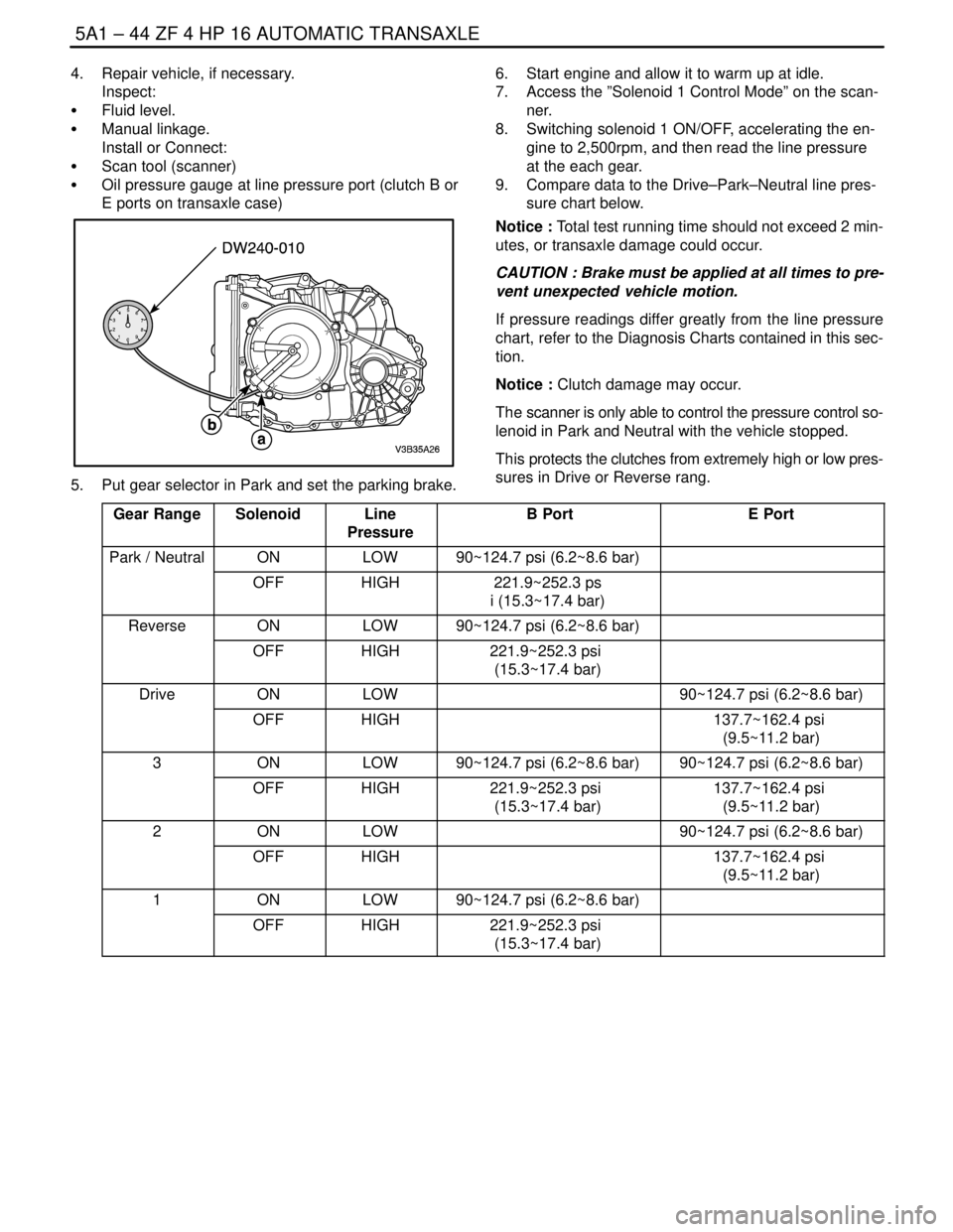2004 DAEWOO LACETTI Reverse gear switch
[x] Cancel search: Reverse gear switchPage 1354 of 2643

ZF 4 HP 16 AUTOMATIC TRANSAXLE 5A1 – 5
DAEWOO V–121 BL4
SPECIFICATIONS
GENERAL SPECIFICATIONS
Definition
Transaxle Type4–speed with four–wheel drive and transverse engine
Input Torque240 NSm (177 lb–ft)
Transaxle Weight76kg (168 lb)
Torque Converter Capacity9.72kg (21.4 lb)
Transaxle Fluid Type (manufacture company)ESSO LT 71141 or TOTAL ATF H50235
Transaxle Fluid Capacity7.3qt (6.9L)
TRANSAXLE GEAR RATIO
GearRatio
First2.719
Second1.487
Third1.000
Fourth0.717
Reverse 2.529
Final3.945:1
FLUID CAPACITY
LitresQuarts
Bottom Pan Removal44.2
Complete Overhaul6.97.3
Torque Converter Removal22.1
(Measurements are approximate)
FASTENER TIGHTENING SPECIFICATIONS
ApplicationNSmLb–FtLb–In
Bearing Plate Bolts23.517.5–
Slotted Nut220162–
Rear Cover Attachment Bolts23.517.5–
Baffle Plate Attachment Bolts10–89
Park/Neutral Position Switch10–89
Fluid Pump Connecting Bolts10–89
Fluid Filter Housing Cover Attachment Bolts10–89
Input Speed sensor Attachment Bolts8–71
Output Speed Sensor Attachment Bolts8–71
Valve Body Bolts8–71
Valve Body Upper & Lower Fixing Bolts6–53
Fluid Pan Connecting Bolts6–53
Fluid Pan Drain Plug4533–
Page 1369 of 2643

5A1 – 20IZF 4 HP 16 AUTOMATIC TRANSAXLE
DAEWOO V–121 BL4
Reverse
In Reverse, transaxle drive is via the input shaft and clutch
B. The elements of this transaxle function are as follows:
S Clutch B is engaged and drives the reverse sun
gear in a clock––wise direction.
S The D band is engaged and holds the planetary
gear carrier (front & rear) stationary causing the
differential pinion to rotate clockwise.
S The differential rotates in a counterclockwise direc-
tion.
S The output shaft is driven in a counterclockwise or
reverse direction.
Control
Clutch B Engaged
The line pressure, which is supplied by the oil pump, is di-
rected to clutch B via the manual valve. The position of the
check ball will change allowing direct pressure to clutch B.
Brake D Engaged
The line pressure, which engaged clutch B, is also sup-
plied to clutch valve D.In Reverse, solenoid 1 is switched ON and EDS 4 is
switched OFF. This will cause the fluid supplied to the re-
duction valve to flow to clutch valve D via the EDS 4.
The spool of clutch valve D will be depressed allowing fluid
to pass to holding valve D.
Lock–up Clutch (TCC)
Solenoid 2 is turned ON and the line pressure control valve
spool will be depressed. Fluid will now flow through the
torque converter pressure valve.
As a result, the oil pressure behind the converter lock–up
clutch piston and in the turbine zone is equal. The direction
of flow is through the turbine shaft and through the space
behind the piston, to the turbine chamber.
Lubrication/Cooling
The lubricating valve ensures that the converter is sup-
plied with cooling oil first if the pump rate is low. The lubri-
cating pressure valve in addition guarantees that the nec-
essary amount of cooling and lubricating oil is available via
the bypass duct.
The fluid, which is supplied from the torque converter,
flows to the cooler via the lubrication valve.
Page 1393 of 2643

5A1 – 44IZF 4 HP 16 AUTOMATIC TRANSAXLE
DAEWOO V–121 BL4
4. Repair vehicle, if necessary.
Inspect:
S Fluid level.
S Manual linkage.
Install or Connect:
S Scan tool (scanner)
S Oil pressure gauge at line pressure port (clutch B or
E ports on transaxle case)
5. Put gear selector in Park and set the parking brake.6. Start engine and allow it to warm up at idle.
7. Access the ”Solenoid 1 Control Mode” on the scan-
ner.
8. Switching solenoid 1 ON/OFF, accelerating the en-
gine to 2,500rpm, and then read the line pressure
at the each gear.
9. Compare data to the Drive–Park–Neutral line pres-
sure chart below.
Notice : Total test running time should not exceed 2 min-
utes, or transaxle damage could occur.
CAUTION : Brake must be applied at all times to pre-
vent unexpected vehicle motion.
If pressure readings differ greatly from the line pressure
chart, refer to the Diagnosis Charts contained in this sec-
tion.
Notice : Clutch damage may occur.
The scanner is only able to control the pressure control so-
lenoid in Park and Neutral with the vehicle stopped.
This protects the clutches from extremely high or low pres-
sures in Drive or Reverse rang.
Gear Range
SolenoidLine
Pressure B PortE Port
Park / NeutralONLOW90~124.7 psi (6.2~8.6 bar)
OFFHIGH221.9~252.3 ps
i (15.3~17.4 bar)
ReverseONLOW90~124.7 psi (6.2~8.6 bar)
OFFHIGH221.9~252.3 psi
(15.3~17.4 bar)
DriveONLOW90~124.7 psi (6.2~8.6 bar)
OFFHIGH137.7~162.4 psi
(9.5~11.2 bar)
3ONLOW90~124.7 psi (6.2~8.6 bar)90~124.7 psi (6.2~8.6 bar)
OFFHIGH221.9~252.3 psi
(15.3~17.4 bar)137.7~162.4 psi
(9.5~11.2 bar)
2ONLOW90~124.7 psi (6.2~8.6 bar)
OFFHIGH137.7~162.4 psi
(9.5~11.2 bar)
1ONLOW90~124.7 psi (6.2~8.6 bar)
OFFHIGH221.9~252.3 psi
(15.3~17.4 bar)
Page 1397 of 2643

5A1 – 48IZF 4 HP 16 AUTOMATIC TRANSAXLE
DAEWOO V–121 BL4
The Lock up clutch should not apply unless the transaxle
has reached a minimum operating temperature of 8°C
(46°F) TRANS TEMP AND engine coolant temp of 50°C
(122°F).
5. Repeat steps 1–4 using several different throttle
angles.
Part Throttle Detent Downshift
At vehicle steeds of 55 to 65km/h (34 to 40mph) in Fourth
gear, quickly increase throttle angle to greater than 50%.
Verify that :
S TCC apply.
S Transaxle downshift to 3rd gear.
S Solenoid 1 turns ON to OFF.
S Solenoid 2 turns OFF.
Full Throttle Detent Downshift
At vehicle speeds of 55 to 65km/h (34 to 40mph)in Fourth
gear, quickly increase throttle angle to its maximum posi-
tion (100%)
Verify that :
S TCC release.
S Transaxle downshift to Second gear immediately.
S Solenoid 1 turns ON to OFF
S Solenoid 2 turns OFF.
Manual Downshifts
1. At vehicle speeds of 60km/h (40mph)in Fourth
gear, release accelerator pedal while moving gear
selector to Manual Third (3). Observe that :
S Transaxle downshift to Third gear immediately.
S Engine slows vehicle down.
2. Move gear selector back to overdrive(D) and accel-
erate to 31mph (50km/h). Release the accelerator
pedal and move the gear selector to Manual
First(1) and observe that :
S Transaxle downshift to second gear immediate-
ly.
S Engine slows vehicle down
Notice : A Manual First––Third Gear Ratio will occur at
high speeds as an upshift safety feature. Do not attempt
to perform this shift.
Coasting Downshifts
1. With the gear selector in Overdrive(D), accelerate
to Fourth gear with TCC applied.
2. Release the accelerator pedal and lightly apply the
brakes, and observe that :
S TCC release.
S Down shifts occur at speeds shown ON the shift
speed chart.
Manual Gear Range Selection
Upshifts in the manual gear ranges are controlled by the
shift solenoids. Perform the following tests by accelerating
at 25 percent TP sensor increments.
Manual Third (3)
S With vehicle stopped, move the gear selector to
Manual third(3) and accelerate to observe :
– 1–2 shift.
– 2–3 shift.
Manual Second (2)
S With vehicle stopped, move the gear selector to
Manual second(2) and accelerate to observe :
– 1–2 shift.
S Accelerate to 40km/h(25mph) and observe :
– 2–3 shift does not occur
– TCC does not apply
Manual First (1)
S With vehicle stopped, move gear selector to Manu-
al First(1). Accelerate to 30km/h(19mph) and ob-
serve :
– No upshifts occur
Reverse (R)
S With vehicle stopped, move gear selector to R(Re-
verse) and observe :
– Solenoid 1 is OFF
– Solenoid 2 is OFF
Use a scan tool to see if any transaxle trouble codes have
been set. Refer to ”Diagnostic Trouble Codes”in this sec-
tion and repair the vehicle as directed. After repairing the
vehicle, perform the hoist test and verify that the code has
not set again.
If the transaxle is not performing well and no trouble codes
have been set, there may be an intermittent condition.
Check all electrical connections for damage or a loose fit.
You also have to perform a snapshot test which can help
catch an intermittent condition that dose not occur long
enough to set a code.
You may want to read ”Electronic Component Diagnosis”
in this section to become familiar with transaxle conditions
caused by transaxle electrical malfunction.
If no trouble codes have been set and the condition is sus-
pected to be hydraulic, take the vehicle on a road test.
TORQUE CONVERTER LOCK–UP
CLUTCH(TCC) DIAGNOSIS
To properly diagnosis the lock–up clutch(TCC) system,
perform all electrical testing first and then the hydraulic
testing.
The TCC is applied by fluid pressure which is controlled by
a solenoid Located inside the valve body. The solenoid is
energized by completing an electrical circuit through a
combination of switches and sensors.
Page 1435 of 2643

5A1 – 86IZF 4 HP 16 AUTOMATIC TRANSAXLE
DAEWOO V–121 BL4
DIAGNOSTIC TROUBLE CODE(DTC) P0705
TRANSMISSION RANGE SENSOR CIRCUIT
MALFUNCTION (PRNDL INPUT)
Circuit Description
The Transmission range switch is located on the selector
shaft and informs the TCM of the current selector lever
position P–R–N–D–3–2–1.
The selector lever position is transmitted to the TCM in en-
coded form along 4 lines. The encoding is such that mal-
functions in the connecting lead are identified.
The TR switch is located on the selector shaft, which is
connected to the selector lever via a pull cable. In addition,
the TR switch controls the starter interlock, the reverse
lights and the selector lever position indicator on the in-
strument panel.
Conditions for Setting The DTC
S TR switch stuck to closed.
S TR switch wiring harness shortage to ground.
S TR switch wiring harness shortage to power.
S Immediately after the above condition occurs.Action Taken When The DTC Sets
S The Malfunction Indicator Lamp(MIL) will illuminate.
S The TCM will record operating conditions at the
time the diagnostic fails. This information will be
stored in the Failure Records buffer.
S Adopt Emergency/ Substitute mode and constant
4th gear.
Conditions for Clearing the MIL/DTC
S The MIL will turn OFF when the malfunction has
not occurred after three–ignition cycles.
S A history DTC will clear after 40 consecutive warm
up cycles without a fault.
S Using a scan tool can clear history DTCs.
Diagnostic Aids
S When DTC P0705 sets, the possible cause of TR
switch.
Page 1585 of 2643

5A1 – 236IZF 4 HP 16 AUTOMATIC TRANSAXLE
DAEWOO V–121 BL4
ELECTRONICAL COMPONENTS
Selector Lever/Program Switch
The driver engages the travel position via the selector le-
ver:
P : Park Position
R : Reverse
N : Neutral
D : Forward Speeds
Park/Neutral Position Switch
The Park/Neutral Position Switch is located on the selec-
tor shaft and informs the TCM of the current selector lever
position P–R–N–D–3–2–1.
The selector lever position is transmitted to the TCM in en-
coded form along 4 lines. The encoding is such that mal-
functions in the connecting lead are identified.
The Park/Neutral Position Switch is located on the selec-
tor shaft, which is connected to the selector lever via a pull
cable. In addition, the Park/Neutral Position Switch con-
trols the starter interlock, the reversing light and the selec-
tor lever position indicator on the instrument panel.
Signal Combination
L1L2L3L4
P00120
R00012
N01200
D1212120
31212012
21201212
10121212
Automatic Transaxle Output Speed Sensor
(A/T OSS)
The vehicle A/T OSS is a magnetic inductive pickup that
relays information relative to vehicle speed to the TCM.
Vehicle speed information is used by the TCM to control
shift timing, line pressure, and TCC (lock–up clutch) apply
and release.
The output speed sensor mounts in the case at the speed
sensor rotor, which is pressed onto the spur gear. An air
gap of 0.1mm~1.3mm(0.004~0.05in) is maintained be-
tween the sensor and the teeth on the spur gear teeth. The
sensor consists of a permanent magnet surrounded by a
coil of wire.
As the differential rotates, an AC signal is generated by the
output speed sensor (OSS).
Automatic Transaxle Input Speed Sensor
(A/T ISS)
The A/T ISS is a magnetic inductive pickup that relays in-
formation relative to transaxle input speed to the TCM.
The TCM uses transaxle input speed information to con-
trol line pressure, TCC apply and release and transaxle
shift patterns. This information is also uses to calculate the
appropriate operating gear ratios and TCC slippage.
The input speed sensor mounts onto piston B that is inside
of valve body.
An air gap of 1.8~2.2mm(0.07~0.086inch) is maintained
between the sensor and the piston B.
The sensor consists of a permanent magnet surrounded
by a coil of wire. As the piston B is driven by the turbine
shaft, an AC signal induced in the input speed sensor.
Higher vehicle speeds induce a higher frequency and volt-
age measurement at the sensor.
Sensor resistance should measure between 825~835
ohms at 20°C (68°F). Sensor can measure from
1,000~8,000HZ.
Page 1592 of 2643

5A2 – 2IAISIN AUTOMATIC TRANSAXLE
DAEWOO V–121 BL4
Shift Control Lever Assembly 5A2–100. . . . . . . . . . . . .
Transmission Range (TR) Switch 5A2–101. . . . . . . . .
Shift Control Cable 5A2–104. . . . . . . . . . . . . . . . . . . . . .
Shift Select Cover 5A2–105. . . . . . . . . . . . . . . . . . . . . .
Input Shaft Speed (ISS) Sensor 5A2–106. . . . . . . . . .
Output Shaft Speed (OSS) Sensor 5A2–107. . . . . . . .
Transmission Control Module (TCM) 5A2–108. . . . . .
Fluid Cooler Inlet Pipes and Hoses 5A2–109. . . . . . . .
Fluid Cooler Outlet Pipes and Hoses 5A2–110. . . . . .
Transaxle Assembly 5A2–111. . . . . . . . . . . . . . . . . . . . .
UNIT REPAIR 5A2–117. . . . . . . . . . . . . . . . . . . . . . . . . . .
Major Component Disassembly 5A2–117. . . . . . . . . . .
Major Component Assembly 5A2–137. . . . . . . . . . . . .
Oil Pump 5A2–167. . . . . . . . . . . . . . . . . . . . . . . . . . . . . . Direct Clutch 5A2–171. . . . . . . . . . . . . . . . . . . . . . . . . . .
Planetary Ring Gear 5A2–178. . . . . . . . . . . . . . . . . . . .
One–Way Clutch 5A2–180. . . . . . . . . . . . . . . . . . . . . . .
Forward and Reverse Clutch 5A2–183. . . . . . . . . . . . .
Counter Driven Gear 5A2–192. . . . . . . . . . . . . . . . . . . .
Valve Body 5A2–195. . . . . . . . . . . . . . . . . . . . . . . . . . . .
Differential Case 5A2–208. . . . . . . . . . . . . . . . . . . . . . . .
GENERAL DESCRIPTION AND SYSTEM
OPERATION5A2–218 . . . . . . . . . . . . . . . . . . . . . . . . . . .
Transaxle Description 5A2–218. . . . . . . . . . . . . . . . . . .
Electronical Components 5A2–218. . . . . . . . . . . . . . . .
Hydraulic Control System 5A2–221. . . . . . . . . . . . . . . .
Automatic Transaxle System 5A2–222. . . . . . . . . . . . .
Page 1637 of 2643

AISIN AUTOMATIC TRANSAXLE 5A2 – 47
DAEWOO V–121 BL4
DIAGNOSTIC TROUBLE CODE (DTC) P0705
TRANSMISSION RANGE (TR) SWITCH CIRCUIT
MALFUNCTION
Conditions for Setting the DTC
S TCM detects more than two equal signals from the
Park/Neutral Position switch circuit for 10 seconds
continuously.
S TCM detects the no signal of TR switch circuit for 2
seconds continuously.
S Vehicle speed is 30 km/h (19 mph) or greater.
S Engine revolution is 1500 rpm or greater.
Action Taken When the DTC Sets
S TCM will request the illumination of MIL and store
DTC when TCM detects failures on two consecu-
tive ignition cycle.
S TCM judges with the priority. (D>2>1>R>N>P)
S No timing solenoid control for N–D
S No self–learning control
S No lockupS No prevent reverse gear control
Conditions for Clearing the DTC
S The TCM turns off the MIL when no further failures
detected for three consecutive ignition cycles.
S The scan tool can clear the DTC from the TCM his-
tory.
S The TCM clears the DTC from the TCM history
memory after forty consecutive warm up cycles
without fault.
S TCM detects single ”D range” signal of the TR
switch.
Cause of Failure
S Wiring harness or connector between TR switch
and TCM
S TR switch
S TCM